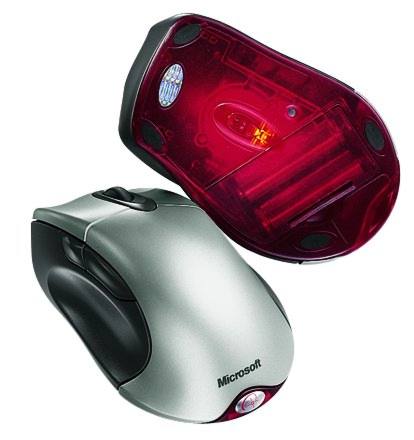| Review: Microsoft Intellimouse
Explorer |
August, 2002
 Microsoft Intellimouse
Explorer
Microsoft Intellimouse
Explorer
System Requirements:
IntelliPoint software for the
Macintosh (included)
Mac OS 8.6 or 9.x
Mac OS 10.1.2-10.1.3 (Separate download)
15 MB of available hard-disk space
CD-ROM drive
An available Universal Serial Bus (USB) port
Price: $49.00 - $55.00 street
Review By
Paul
Marengo
The following is a synopsis of my
experience working with the Microsoft Intellimouse Explorer.
It has greatly helped to speed up my productivity with Final
Cut Pro.
I
started editing on Avid Media Compose in 1993. After many years
of editing I found that speed is a great asset. When I switched
to FCP most of my speed was lost. So I started looking for options
to get back to a professional pace. Now though, I had options
with FCP and USB.
The Shuttle Pro was my first try and I found it hard to place my hand over the jog control all day. So I then found the Microsoft Intellimouse Explorer.
This optical mouse has a great ergonomic
design and many programmable buttons. (NOT the wireless version;
it's not as responsive) You can find drivers for OS 9.x and OS
10.x at www.microsoft.com/mac/. The examples shown are OS 10.x.
The same results can be achieved in OS 9.x but I suggest switching
to 10.x soon.
After installing the drivers you will
find a new option in your System Preferences. Select the Microsoft
Mouse preference located under the category "other."
So here is how I set it up.

Once inside this preference you have many options for programming
the mouse. I set up Final Cut Pro as my "specific application"
although it allows the mouse to have different settings for any
application you choose.
Examples: Photoshop, After Effects, Maya, Shake etc.
The preference is broken into three categories.
These three categories list Pointer Options, Buttons, and Wheel.
Each of these tabs allows you to assign a keyboard command to
one of the five buttons and one wheel on the mouse. Just like
a normal "two button mouse," you have a button for
your index and middle fingers. The index finger (left click)
is just like an Apple mouse. Your middle finger is on the second
button (right click) and acts the same as control with left click
together. Nothing fancy yet. It's the wheel between those two
buttons that can be programmed for different tasks.
The wheel has three motions. Roll foreword
and back, plus when pushed down it acts like a third button.
I programmed the roll foreword to act as zoom in. The command
for this is the Apple and plus keys together. The same for roll
back, but it zooms out. The command for this is Apple and minus
keys together. This allows you to quickly zoom in and out on
your timeline or window with just a slight movement on the wheel.
(Actually, Paul Saccone had the idea of making the scroll wheel
zoom. Good man!) I'm constantly zooming in and out to get around
a large timeline.
I then programmed the "wheel button
(push wheel down for this) to always take me back to selection
mode. I feel most comfortable editing in selection mode and it's
a good default place to start on each new clip. My only complaint
is how FCP defaults to the canvas window after cutting in a clip.
Example: you cut in a shot from the viewer to the timeline. You
want to zoom in on your edit and you find you are zooming in
on the canvas and not the timeline. After a while you get use
to clicking on the timeline before zooming in. I hope Apple changes
this.
So we have our first three buttons and
our scroll wheel. Where are the other two buttons? They are where
your thumb rests on the side. They're side by side and also allow
programming. I found that I constantly want to adjust clips after
cutting them into the timeline. So I programmed the front thumb
button to act as if hitting the "R on the keyboard. This
takes you to roll edit when clicked once and ripple edit when
clicked twice. Great for adjusting the in and out of a clip on
the timeline. The second thumb button was programmed to act the
same as hitting the "S" on the keyboard. When clicked
once you are in slip item mode and when clicked twice you are
in slide item mode. Slip item is a big help. You don't have to
re-cut the clip to get a different timing. Just slip or slide
your footage and continue on. No re-cutting footage from the
viewer.
I use these five buttons the most but
you may find other commands enhance your style. Try different
configurations until you are comfortable. It takes time to get
acclimated but it's worth the effort.
Well, that's all folks. Hope you find
this helpful and find your own ways of programming the Microsoft
Intellimouse Explorer to speed things up. A fast editor is always
in demand. As long as your shows don't suffer from haste. Happy
editing. GO APPLE!
Paul Marengo
Editor
Copyright © Paul Marengo,
2002
All
screen captures and textual references are the property and trademark
of their creators/owners/publishers.
Paul
Marengo is an Emmy-nominated editor with fourteen years of
experience. His background consists of programs with Discovery
Channel, Fox Family Channel, TLC, The History Channel, Directors
Guild of America, Columbia/Tri-Star, Warner Brothers, and The
Academy of Motion Picture Arts and Sciences. He is currently
using FCP in his own West Los Angeles office and is open to new
clients.